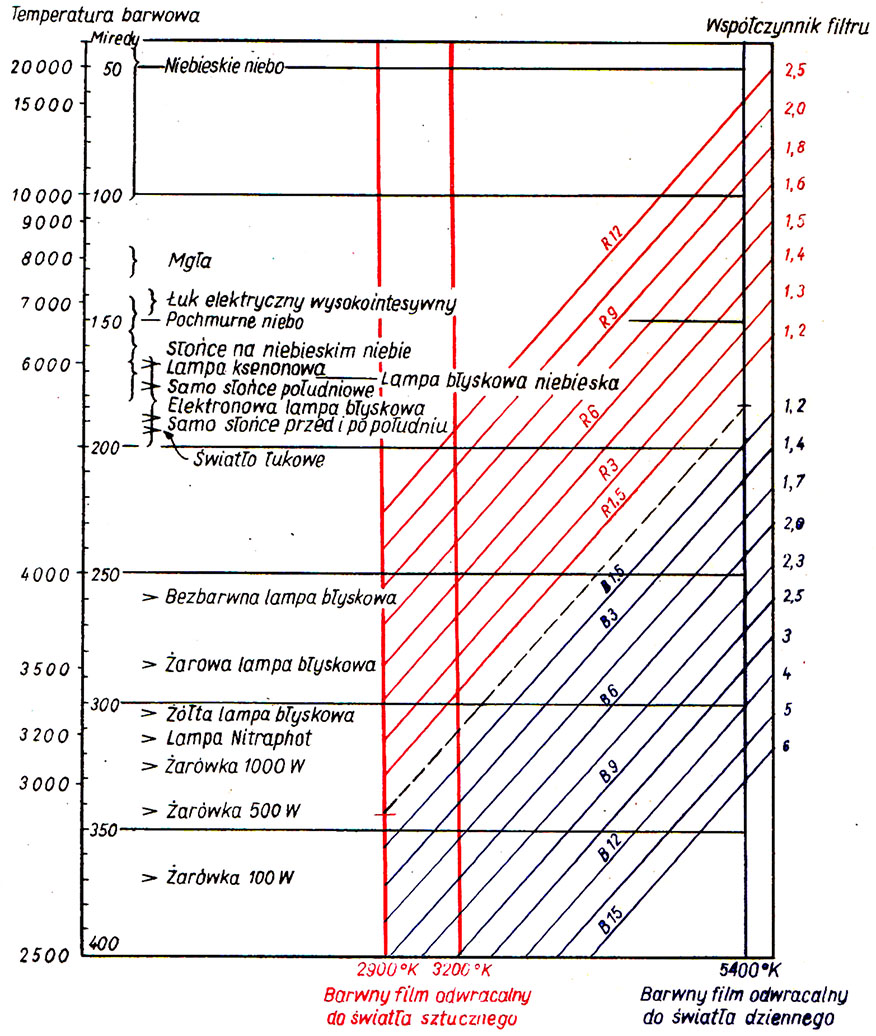Color temperature graph.
Now let's look at the chart further. In the middle of the figure there are three vertical lines - two red and one blue, which correspond to materials reversible to artificial light (type K) and reversible materials designed for daylight (typ T).

We know, that both types of materials can work only at a certain color temperature without the formation of incorrect color shades on them. Dashes are marked on both vertical lines at the respective color temperatures. Both dashes are connected by a dashed line, and parallel to it run the red and blue lines used to compare light and filters. Their designation is given in decamireds. On the right side of the figure, the exposure coefficients for the filters are given in the colors corresponding to the individual lines. Finally, on the left-hand side, practically existing types of lighting and the corresponding light color temperatures are listed. These values may have significant deviations, because with artificial light sources they depend on the product and on the current voltage, and in daylight - on the time of day and year, as well as from the weather. The values on the side in parentheses indicate the expected scatter ranges. Flash lights also glow at a constant color temperature. At the moment of their strongest discharge, they reach up to 5000 K, so that if the camera has good synchronization and can capture the maximum exposure even with untinted lamp glass, can be loaded with material intended for daylight (typ T). The average temperature in most instruments, however, is much lower. Using a somewhat complicated look, but nevertheless a fairly clear drawing, as we will explain with an example, should be as follows: The flash lamp with untinted glass has a color temperature of approx. 3800°K or 263 lurking, so it lies between the color temperatures, to which both types of reversible materials are suited, np. ORWO or other tape manufacturers. At the height corresponding to the color temperature of the flash lamp with untinted glass, we draw a horizontal straight line to the right, until it intersects with the red line corresponding to materials intended for artificial light. The horizontal line intersects the first line at about the same height as the red line corresponding to the R filter 9. This filter would therefore be correct for a material intended for artificial light: it lowers the mired value, flash to this one, to which the photosensitive material is adapted. Moving along the red line to the upper right, we can read the filter factor of 1,8. However, if we move at the height corresponding to the mired value of the flash horizontally even further to the right, we will come across the second red line of materials intended for artificial light at a temperature of. 3200°K. At the same height, it is intersected by the filter lines R 6 i R 4,5. Both filters are equally suitable for this film. Even further, horizontally to the right, we come across a line of material intended for daylight, intersected by the blue line of filter B 7,5. So this would be a filter suitable for daytime material type T. The filter factor would be correspondingly higher and would be in this case 2,3.